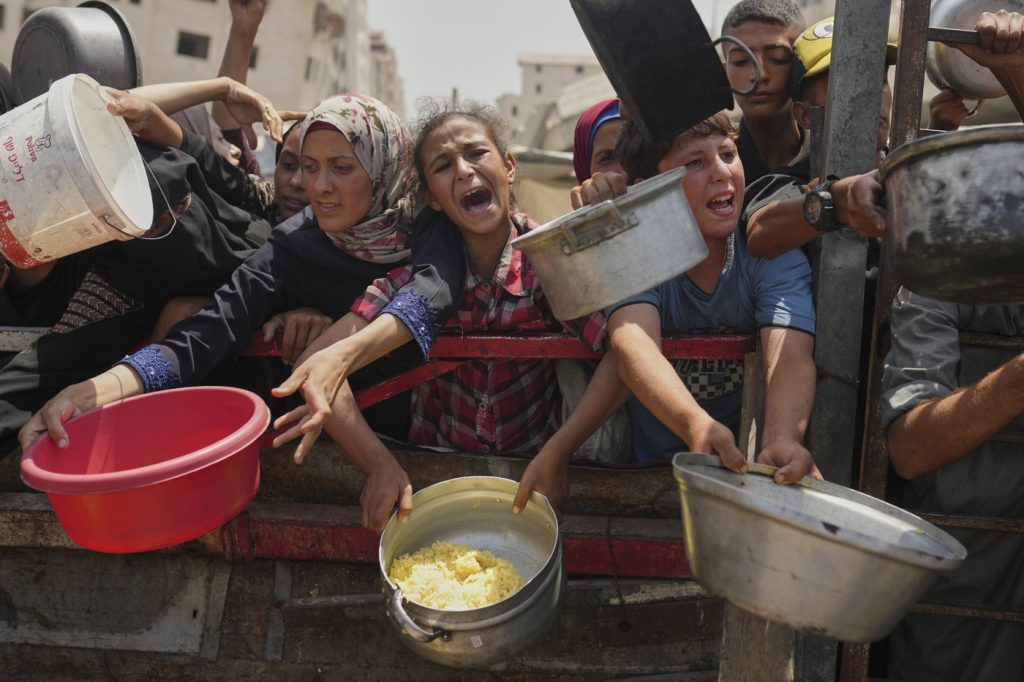Gaza City, Gaza Strip (AP) – The Integrated Food Security Phase Classification (IPC), the world's leading authority on food crises, reported on Friday that Gaza City's largest urban area is currently facing famine, with the risk of this condition spreading to other parts of the territory without a ceasefire and an end to humanitarian aid restrictions. The report highlights that Gaza City, which is home to hundreds of thousands of Palestinians, is encountering alarming levels of starvation, particularly among children.
The IPC's announcement marks the first official confirmation of famine in the Middle East. As the situation escalates, international pressure on Israel is likely to increase, especially as Israel continues its military operations against Hamas, exacerbating the hunger crisis. Following Hamas’s attack on October 7, 2023, Israeli Prime Minister Benjamin Netanyahu indicated plans to intensify military actions aimed at seizing Gaza City and other Hamas strongholds, which experts warn will worsen the ongoing hunger situation.
According to the IPC, widespread displacement due to the conflict, coupled with the blockade that restricts food and other vital aid, has driven hunger to life-threatening levels throughout Gaza following 22 months of conflict. Over half a million people, approximately a quarter of Gaza's population, are reported to be facing catastrophic levels of hunger. Last month, the IPC indicated that the “worst-case scenario of famine” was unfolding in Gaza, although they refrained from making an official determination at that time.
Despite these reports, Netanyahu dismissed the accounts of hunger as “lies” propagated by Hamas. In response to images depicting malnourished children and reports of hunger-related deaths, Israel claimed to loosen some restrictions on humanitarian aid. However, the United Nations and local Palestinians assert that the amount of aid entering the territory is still significantly below what is necessary to meet the needs of the population.
The Israeli military agency responsible for the aid transfer to Gaza, known as COGAT, rejected the IPC's famine report, describing it as “false and biased.” It insisted that significant measures have been taken to increase the volume of aid flowing into Gaza in recent weeks. Furthermore, Israel’s foreign ministry characterized the IPC findings as based on “Hamas lies,” asserting that over 100,000 trucks of aid have entered Gaza since the conflict's onset, including substantial amounts of staple foods.
Analysts contend that the situation has turned dire, with increasing numbers of people, especially children, dying from preventable causes due to malnutrition and disease. Chris Newton, an analyst from the International Crisis Group, stated that the escalation of military operations in Gaza implies that the famine situation in the region is intentional and indicative of how Israel is utilizing starvation as a tactic.
Formal famine determinations are rare, and the IPC typically identifies famine conditions when at least 20% of households face extreme food shortages, 30% of children between 6 months to 5 years suffer from acute malnutrition, and two people or four children under five perish daily from starvation or related causes. Data collected from Gaza between July 1 and August 15 showed alarming indicators of starvation and malnutrition, although gathering mortality data has proven challenging due to ongoing military actions.
Experts suggest the ongoing conflict and Israeli restrictions on access have severely hampered data collection efforts, leading to underreported levels of hunger. Notably, the IPC projected that one-third of Gaza's population could encounter catastrophic hunger levels by the end of September, which may reveal an even more dire situation than previously acknowledged.
Medical professionals in Gaza have reported a concerning rise in malnourished patients. Kirsty Blacka, an Australian emergency nurse, noted an influx of visibly emaciated individuals, indicating that starvation is compounded by other health complications due to contaminated water and diseases. Blacka expressed concerns over the potential mortality of those unable to evacuate due to deteriorating health conditions exacerbated by starvation.
Families in Gaza City report heart-wrenching accounts of watching loved ones suffer from malnourishment. Yousef Sbeteh described the plight of his two injured teenage children, who lost substantial weight while hospitalized due to a lack of food. The rising prices in markets have further compounded the issue, making it increasingly difficult for families to access essential nutrition.
As the situation in Gaza City deteriorates, with neighborhoods bearing the brunt of ongoing military action, the humanitarian crisis intensifies, raising urgent calls for more effective aid and support for the millions suffering within the region.










